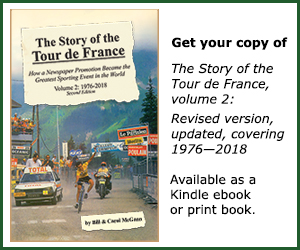The Milan 2004 Eicma Bike Show
and then on to Vienna and Prague
Last year we skipped the 2003 Milan bicycle show which is called Eicma by the Italians. With both technological and distributional change in the bike industry accelerating, we knew that attending the big Italian show in 2004 was a necessity. Like maintaining a position in a fast-moving aggressive peloton, if you stay in place you fall behind.
Now it's not that we don't want to go. Any excuse to get over to beautiful Italy is usually excuse enough. But with the big American Interbike show at Las Vegas show coming hot on the heels of Eicma, getting all the preparations for showing in Las Vegas ahead of time before jetting off to Milan seemed just hard enough to give us pause.
The complicating factor is the evil (to us) European August vacation. In Italy, France and parts of Germany everything shuts down for the month of August. When the Italian factories reopen in late August or early September the Italian producers scramble to get catalogs printed, samples shipped and prices finalized for the show season. Some staffers have to come back to work early to get things ready. That's one effect of globalization. The August vacation gets ever shorter as the Mediterranean countries are forced to match the commercial requirements of the rest of the world. Parentini Clothing stayed open until August 10 and several of our Italian suppliers were hard at work by the third week of August.
The first cycle show of the season is called Eurobike. It is held in the first week in September. Then Eicma comes in mid-September. Stupidly, it overlaps the big Cologne Show, called IFMA. Then either in late September or early October, Interbike rolls along. Having been on the go since early September, executives of some of the Italian companies look like death warmed over by the end of Interbike.
As I write this, just after leaving Eicma, our final samples are on the way and everything is set for Interbike. After leaving Eicma and getting most of the final details set (or at least in motion) for our 2005 Torelli product lines (including Mondonico, Guerciotti, Vittoria and Parentini), I don't think I've ever been so excited about the year to come. We do have some hot stuff for 2005.
Friday, September 17, first day of the show.
Computers promise so much and fail so often. Like most people I usually find myself cursing them and the infuriating complications they can bring. This time, against all expectations, Italian computers saved time and trouble.
A few years ago we showed up to register for the Milan show. The registration room was an unbelievably crowded, filled beyond capacity with show visitors pushing and shoving to get to the registration counter and into the show. The packed room was hot and the experience miserable and almost scary.
This time we registered in advance online. Arriving at the show hall, we walked up to an empty counter, gave our names to a pretty girl and were handed our passes. The whole process took seconds. I wish it were that easy at Interbike (post-Interbike note: this year it was that easy).
We headed for our first appointment, Guerciotti Bicycles. Owner Paolo Guerciotti's son, Alessandro, had promised us some sharp, trick Guerciotti bikes for 2005. Hot diggity! New sexy Italian bikes! Just the thought puts a song in my heart, a smile on my face and a spring in my step.
Standing at their booth as the show opened was the entire Guerciotti family: Paolo, his wife Mary, daughter Micaela (Miky) and son Alessandro. Also there was one of Paolo's many ex-pro rider friends, Marcel Tinazzi.
Tinazzi rode with Freddy Maertens on the famous Flandria team as well as having put in a stint with Sean Kelly on the SEM squad. Tinazzi is the gent who provides Paolo with his sharp-looking Guerciotti clothing. Whenever I meet one of these giants of the road, I forget business. I turn into a blithering, pathetic sports fan.
Signor Tinazzi, who was French Road Champion in 1977, turned out to be a fine fellow. I explained to him my Tour de France history and my oral history project. He promised to help me out. Signor Tinazzi has, I think, three completed Tours under his belt as well as several Giri.
After Signor Tinazzi had satisfied my inner tifoso (rabid sports fan), we had Alessandro walk us through the 2005 Guerciotti bike line. First, he showed me a new carbon cyclocross frame, the Comete Cross. It was light enough for even me to consider carrying it up a muddy hill. The other two cross frames, the EM2 and the Force remain unchanged for 2005. For the road, the most dazzling new bike was his carbon monocoque Cartesio made from Deda's Black Pearl carbon fiber. Visually it was an absolute stunner. The rest of the Guerciotti line was mostly unchanged going into 2005 with some with a few touch-ups to the graphics.
 |
|||
|
Top to bottom: Guerciotti's Comete Cross carbon cyclocross frame; Alessandro Guerciotti with the Cartesio; the 2004 LPR Team bike. |
|||
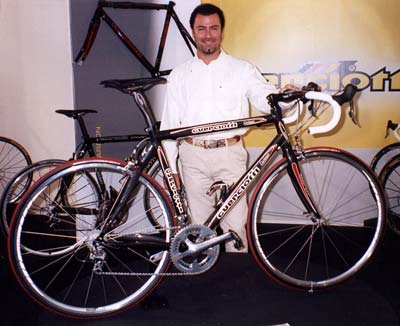 |
|||
 |
|||
Next appointment, Columbus Tubing. Diego Colosio, the manager of Columbus along with Fabrizio Aghito, the head of their research department, sat down with us. We both wanted to do a little redesigning to our proprietary tubing sets in order to incorporate their latest metallurgical advances utilizing Niobium alloys. Eventually the special tubeset we use for Torelli/Nemo 747 will be discontinued. Both Colosio and Aghito know that our first concern is ride quality, not fancy-looking tubing profiles that can only make a bikes ride harsher. We were able to craft a proprietary tubeset with nearly identical specifications to our 747 tubeset using a blend of Spirit and Life Niobium alloy tubes. It will be a seamless transition with no discernable change to the frames and their ride. Columbus, as always, was very accommodating in working out a creative solution for my requirement that our professional steel bikes all have 0.4mm wall thickness in the main tubes when building frames smaller than 60 centimeters.
While the changes were few and small we just keep making sure that with each year's passing we have all of our designs and specifications optimized. Over the years, these little improvements add up to a lot.
The conservative, careful approach Columbus takes to their tubing and component designs makes a good fit with Torelli. When a customer like you has invested so much in a bike, it should be made with the understanding that it must be a reliable, dependable piece of machinery. With the use of aluminum alloys in bike frames, this reliability does have severe limits compared to steel, but that does not absolve us of the obligation to do the best we can. And we still need to make it go like a bat outa hell. At this time, we think those two goals are best achieved using Columbus tubing.
As we were finishing up with Colosio and Aghito, Carol's cell phone rang. Franco Bitossi had come to the Guerciotti booth and was waiting for us. Franco Bitossi!
Whoosh! We were gone in a flash!
I had never met Signor Bitossi. We've only talked on the phone. There, grey and older, was that same face that I had seen in a thousand racing pictures from the 1960's and 1970's. This was the great Franco Bitossi who was unbelievably close to being World Champion twice, who was so complete a rider that he was able to win both the climber's and the sprinter's categories in the Giro. In the 1968 Tour de France he was sitting in fourth place with one stage to go, only 58 seconds down on leader Van Springle. He would have won it had he had a better final time trial. As it was, he walked off with the Green Jersey.
I showed him a printout of a list of his victories, totaling 90 pro wins. He said no, that was wrong. "Novanta, no. Cento, cinquata" (Ninety, no; one hundred and fifty). That's right, one hundred and fifty professional victories. To give you an idea of the magnitude of this accomplishment, Alessandro Petacchi won more races than anyone this year with 21 pro victories. And Bitossi had Merckx and Gimondi, among others, to contend with for victory. His wins were great because his competition was great.
Bitossi reminded me that his heart problems kept him from winning more races. He was known as the racer with the "il cuore matto", the man with the crazy heart. Marcel Tinazzi showed up again and the two of them reminisced about their days of greatness.
My good friend (and ace Torelli reporter) Valeria Paoletti has an appointment to talk to Bitossi at length about that 1968 Tour for our oral history project. Watch for it on our site. I couldn't wait for Valeria's report. I had to jump the gun and ask the great man some of the questions that had come to me as I wrote my Tour de France history. I asked him if the 1968 Tour was as brutal and as hard fought as the histories say. He said it was indeed very difficult, as was the 1970 Tour. I can't wait for Valeria to get this interview done!
 |
||||
|
Domenico and Serena Modolo |
||||
We stopped by the Modolo booth. Serena, the business manager of the company and her husband Domenico, Modolo's designer and technician, showed me the completely re-designed Modolo bar and stem line. Most notable to me was the Venus bar. The Venus handlebar might have been the first women's specific bar on the market. Now they have re-thought the exact shape of the bend so that small hands can be comfortable no matter where they are placed. They have also increased the size range going all the way down to 34 centimeters in width, measured center to center. We should have them in stock before the end of winter.
Our last stop for the day was Marchisio who make the multicompatible sprockets that fit almost any freehub. Two new improvements to their line were on display at the show. First, and most wonderfully, they have eliminated the little anti-flex spacers that are stuck individually on the larger cogs. Now, they have an anti-flex ring that slides over the distancing spacer. Marchisio sprockets are a bit complicated, but any user of their products will read this and rejoice. It's all now much, much neater. Also, they'll have cog compatibility with Dura-Ace 10. Both of these should be in our warehouse by the end of the year.
As Carol and I wandered the show for the first day, carbon was the most notable material. This was completely expected. It was everywhere and on everything. Two years ago I thought carbon was big. Then I was amused to see carbon fiber mini-pumps. Now, the use of carbon has grown exponentially. It is omnipresent. I can think of almost no component that didn't have some offering in carbon somewhere in the show.
Saturday, September 18
Our first stop was the Parentini clothing booth. The owner, Gianpaolo Parentini, gave us the latest news about his factory. He's bought several more digital printers. This is very good news. The upshot of this new equipment is a reduction of the minimum number of items in a custom clothing order. Heretofore, unless a substantial premium was paid, the minimum number of custom garments he could produce was 50. The custom graphics are printed on papers that are held against the fabric under intense heat and pressure. These papers are printed by a special serigraphy house whose minimum is fifty pieces. This drives the calculus of custom clothing. With several digital printers in-house, Parentini can produce the sublimation papers himself in any quantities needed. We'll have an all new price list for custom Parentini clothing in a couple of weeks. Mr. Parentini said he just couldn't get the 2005 price list done in time for Eicma (note the explanation regarding the August vacation above).
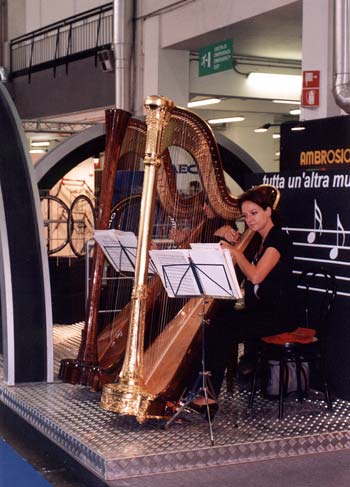 |
||
|
The music in Ambrosio's booth was somehow more civilized than some others... |
||
Next visit, Ambrosio, who produces our rims in their factory just outside Milan. Marzio Marzorati, the owner, and I began designing two models of wheels that would have all of their component parts made entirely in Italy: hubs, spokes and rims. We wanted to have an economical set of wheels that preserved the quality of ride. That means tangential spoking, medium spoke tension and rims with a medium depth cross-section We should have the nuts and bolts worked out in a few weeks as we ponder the fine details. He also gave me the sad news that our Master rim will no longer be available. I can't buy enough of them to make drawing the extrusion worthwhile and the rest of the world wants deeper aero-looking rims. When our supply of Master rims is gone, that will be it.
Campagnolo doesn't make their famous frame preparation tools any more. Those beautiful tool kits that a professional shop owns with special pride are out of production. For years I have admired the exquisite tools Silva of Italy makes. The reader may be more familiar with Silva as the maker of handlebar tape that often shows up on the bikes of professional riders. That's one-half of the production of this small firm.
One beauty of the Silva cutting tools (taps, dies, mills, etc.) is that they fit on Campagnolo, Cobra and Gipemme handles. This will give new life to those who have bought these frighteningly expensive tools (and expensive they were) and are now looking for replacement parts. I have to give the entire catalog a thorough study, but we should have Silva tools in stock by December.
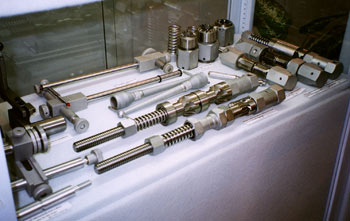 |
||||
|
Some of Silva's frame preparation tools (left), and their bike cleaning stand (below). |
||||
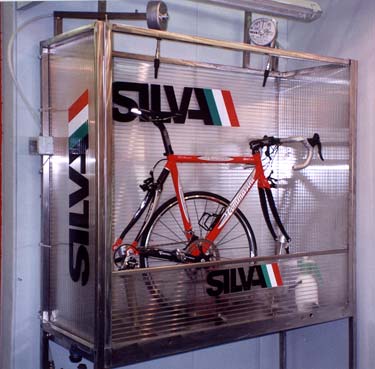 |
||||
Silva had one neat item that I drooled over, but had to pass. They make a beautiful enclosed stainless steel bike cleaning station with hoses on reels dispensing solvent and compressed air. Nifty, but at about $3,000, a bit high for the convenience. If I get the right Lotto numbers, I'll have one on the way.
We sat down with our builder of the Torelli Corsa Strada and Express steel frames. We had to get him up to speed regarding the new Torelli tubesets and make sure that we were all agreed upon the pricing. No problem there. Again, a seamless running change.
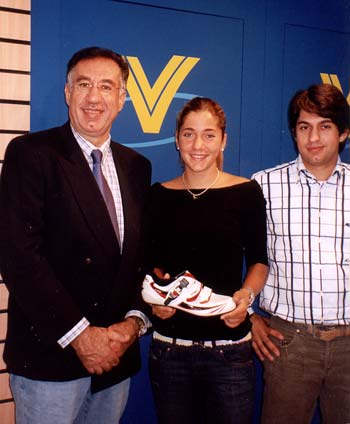 |
|||
|
Celestino Vercelli (left), with daughter Veronica and son Edoardo, along with the new Unlimited Vittoria shoe. |
|||
The final visit of the day was at Vittoria Shoes. Owner Celestino Vercelli had redesigned the less expensive shoes, substantially improving their specifications and appearance. In 2005, all Vittoria shoes will get an injection molded heel-counter (or heel-cup). Also, all road shoes get the outsole that used to be reserved for the highest-end shoes. Previously, the mid-line and less expensive shoes received a nylon sole while the best shoes were fitted with a nylon/carbon-composite sole unless a full-carbon sole was specified. This Vittoria composite sole was used by both Marco Pantani and Stefano Garzelli for their Tour and Giro wins. Now this composite sole will be used on all of the Vittoria road shoes unless the Heart of Carbon or Full Carbon sole is fitted. Sweet.
The top of the line Vittoria Shoe, the "Unlimited" (formerly the "Arrow") has a new color, white. The most popular color in the U.S., the blue and white, is going to be made just because Americans like the colors so much. We buy most of them. I was surprised, but in Italy, the land of the "Squadra Azzurro" (the blue team), the blue/white shoes are not popular at all. The silver and black of 2004 will become black with black mesh for 2005.
Currently, Vittoria is also studying the introduction of women's shoes but did not yet have things finalized. Their plan is to use the present colors, but to build them on special women's lasts. Lasts are the forms around which the shoe is built. That's what give a shoe its particular internal shape. [Post show note: Vittoria is studying the best way to make a women's shoe. They want to make sure it is done correctly. The Vercellis believe they will have the shoes ready for the 2005 season. Also, Vittoria announced a restructuring of their price list. Now, Vittoria shoes are at least 10% lower than in 2004. This is also a very sweet deal.]
Sunday, September 19
We started the day with breakfast at our hotel with the Mondonicos. I don't think there was ever a more timely pair of people put on this earth than Antonio and Mauro Mondonico. I came down from my room several minutes early and they were waiting for me. Nice people never want to inconvenience others and the Mondonicos are nice people.
We met to discuss the changes in the tubing that Columbus was offering. Mauro actually knows more about what is exactly in the Columbus inventory that the Columbus executives. He likes to go into their warehouse and sniff around to find the exact tubing needed to make the perfect frame for his customers. Mauro was confident that Columbus' inventory of 2004 tubing was more than enough to meet his needs for 2005. There are some requirements that Mondonico has that are be most economically and perfectly fulfilled with certain tubings that are no longer in the Columbus catalog but still in their inventory.
Antonio and Mauro also wanted to make a special offer to customers who would want to book their frame orders during the winter when things are slower. They were having discussions with Columbus to come up with a limited time sale, probably a free upgrade to the next better model. An EL-OS for the price of a Diamond, for instance. Mauro said that when I returned to the U.S., he would have the details worked out. [Post show note: indeed, Mondonico and Columbus did arrive at a fantastic promotion. Until December 15, 2004, a rider may order a Futura Leggero and have it built with EL-OS or Neuron at no extra charge. Or, a rider may order a Mondonico EL-OS and have it built with Foco at no extra charge]
Our last meeting was with the maker of our tires. We have all new technology available to us now. Again, the details won't be worked out until we meet again at Interbike, but we expect to be able to offer 220 - 320 threads per inch casings on cold-treated open tubulars at some wonderful prices. We should also have a professional racing and an inexpensive training tubular for 2005. This is hot stuff. I'm about coming out of my skin in anticipation. [Post Interbike note: indeed, we will have our first Open Tubular, project named "Verona" made with a 220 TPI casing sometime in January. It should retail for about $28.00]
Leaving the Milan show I was left with the general impression that industry observers were correct. The great Milan Show is turning into a regional show. The 2004 Eicma was about 25% smaller than the 2003 version. I think there were two forces at work. First of all, the consolidation that is hitting all industries all over the world has not left the Italian bicycle industry untouched. Many smaller firms had either been absorbed by their larger competitors or have gone out of business altogether. Also, with ferocious competition coming from China and Taiwan, the Europeans are being forced to trim their prices. The margins factories got just a few short years ago are much tighter. With three huge European shows (Cologne, Friedrichshafen, Milan), there is less money to shower on the monstrously expensive trade shows. The edge seems to be going to Freidrichshafen's Eurobike. The component factories can get better access to the importer's and bike factory's buyers at Eurobike.
While globablization is having its way with so many small firms around the world, sharp, clever, devoted companies in Italy are still producing beautiful hand-made products for the cycling connoisseur. Don't let anyone tell you otherwise.
That was the end of our Milan show visit. The generous and kindly Mondonicos picked us up and took us to the Malpensa/Milano airport for the next chapter in our Fall trip, visits to Vienna and Prague.
What follows is my travel diary to these two beautiful cities. I didn't bring my bike, so there's no cycling or anything about bikes at all in the pages that follow.
Vienna. I've never been here before. It sits just a little bit too far to the East to be convenient. Heading north and south to and from Milan, Zurich and Munich, I've had the good fortune to stay in Innsbruck and Salzburg, but I have never made it to the great heart of the Hapsburg empire.
The first thing one notices and admires about landing at the Vienna airport is the clear directions for transit. I can't count how many times I've arrived at an airport and gone almost out of my mind trying to figure out how to get into the city without spending the equivalent of the gross national product of Belgium on a taxi ride. Dulles Airport in Washington D.C. especially comes to mind here.
At the Vienna airport one simply follows the easily understood signs to the train into town. Clear and neat. The next hobgoblin in most cities is figuring out how to buy a ticket. So many train stations are automated with no human help available anywhere. The maps and rates and dispensing machines are probably clear to a local. It seems to escape transit authorities all over the world that most of the people getting off an airplane are not locals and don't speak the language. In Vienna, no problem. Again the signage was clear and in several languages. In seconds we had our tickets and were waiting for the train to town. The train was immaculate, quiet and a joy to ride. Vienna's mass transit system is well done.
Our hotel was the "Astoria". I should have been warned when one fax from my travel agent's book called it "quaint". That's optimistic guide-book speak for "worn", "aging" or "down at the heels". An indifferent and not terribly friendly desk clerk checked us in. He said he would call for a bell-man. I told him that we had carried our little bags across two continents and one ocean including three airports that day alone. We could easily take the elevator to the room with our small luggage. Nope. The hotel was intent upon giving us a little shake-down. The bellman took us to our little, very dumpy room (149 Euros, or $180!!). We tipped him and sent him on his way. Now, in fairness to the Astoria, things got a bit better. After complaining the next day about getting a room that a Motel 6 would never consider offering, we were moved to a larger, less.....shall I say less disappointing room. Still beat-up, still expensive, but tolerable. And still not as nice as Motel 6.
Monday, September 20
What a glorious day. The temperature was in the mid-seventies with a bright sun and little puffs of cloud-cotton-candy floated in the blue sky. A wonderful coda to the summer. I had to pinch myself. We were in Vienna, for centuries the capitol of the Hapsburg Empire and one of the cultural centers of the world.
In the beginning Vienna was an outpost at the edge of the Roman Empire. Called Vidobona, this is where the philosopher-emperor Marcus Aurelius died fighting the invading Germanic tribes.
Outraging the Pope, in 1192, Richard the Lionheart was captured in Austria as he was returning from the Crusades. With the ransom the English paid to get their king set free, the Viennese built a ring of fortifications around their city. Again, faith shouldn't be allowed to get in the way of money and power. It rarely does.
When I was twelve years old I became rather ill. To pass the time, I read a book of central European history. I still wonder how I ended up reading that old book or where it came from. That was when I first became fascinated by the Hapsburg dynasty. The maps in that long-lost book showed the domains of the family growing relentlessly with each century. The Hapsburg story was different and completely disconnected from the usual American and British history I was taught. These Bohemians and Austrians were exotic to me. My interest never waned.
Starting with lands in Bohemia, the Hapsburg family started consolidating power in the 13th century. They kept at it until they were the Holy Roman Emperors (Voltaire said that by the late 18th century it was neither holy, Roman, nor an Empire, but I digress) and the masters of Holland, Belgium, Spain, Austria, Hungary, Burgundy and serious chunks of Germany. In addition they ruled South, Central and much of North America. Their motto was Austria Est Imperare Orbi Universo (Austria shall rule the world).
With careful marriages, they acquired this massive domain with far less warfare than would have been expected. Unlike our present time, then the frank application of power didn't need the usual questionable fig-leaf of virtue. The Hapsburgs were not afraid to use force when needed, as the Indians of the Americas can sadly attest, as can also the rebellious Dutch, Italians and even the Viennese.
It was a huge empire that grew too large for one man to rule. Charles V, who crisscrosses history at so many pivotal points, whether it's the Protestant Reformation or the Italian Renaissance, split the empire in two in 1521. He gave his brother the Austrian and Central European possessions. His son, Phillip II, was given Spain, Holland and the New World.
That brilliant manipulator of 19th century politics, Austria's Prince Metternich, said that Asia begins at the Landstrasse, a neighborhood in Vienna. Twice the Turks came to the gates of Vienna. The second time the city came under Turkish siege was in 1683. Only the Poles helped the Austrians as the other great Christian kings (including France's Louis XIV) and princes stood by hoping that the Austria's rulers, the Hapsburgs, would be weakened or destroyed by the Turkish juggernaut. It does give one pause. The Western Kings ruled by divine right. They said they were put on earth by God to rule men in his stead. Yet, a little chance to weaken a fellow Christian who is a rival and that most Christian executorship is forgotten. Faith can be so ennobling.
The Austrians prevailed over their Eastern foe and sent the Ottomans packing. Yet, still, it's no understatement that to say that when one is in Vienna, one is at the edge of the Western World.
The Hapsburgs were the proximate cause of the great tragedy of the Twentieth Century. In 1914, Serbian Gavrilo Princip assassinated Archduke Franz-Ferdinand, the heir to the Hapsburg empire. A series of mindless ultimatums from the aging Austrian Emperor Franz-Josef to Serbia tripped the wires of the series of interlocking European alliances that guaranteed to bring all of Europe into what should have been a small conflict. As has happened so often in history, protective alliances took a local conflict and made it tragically international. All of Europe heartily joined the mutual massacre.
After four years of slaughter, in what can only be seen as what might be the greatest episode of stupid, shortsighted small-mindedness in history, France and England forced Austria and Germany to sign the terribly punitive Versailles peace treaty. This guaranteed the continuation of the conflict (we call it World War Two) at the earliest possible moment. Perhaps 100 million people died as a result of the angry old Hapsburg's intent to punish Serbia.
Franz-Joseph died midway through World War One. His new heir, Karl, was forced to abdicate at the end of the war. Most of the Hapsburg possessions were nationalized. In light of the misery that they caused, abdication seems a small price for the Hapsburg dynasty to pay. I believe the Pope just beatified Karl, who had troops under his command use poison gas in World War One. I guess when he attains sainthood he can become the patron saint of chemical warfare.
Traveling through Vienna, one senses a bit of sad nostalgia. Visitors often misunderstand things, but I felt a touch of ambivalence over the subject, perhaps even a tinge of regret at the fall of the house of Hapsburg. It seems that figuring out how to deal with their Imperial past is a problem that the Austrians haven't completely settled.
Since America still has not come to terms with the attempted genocide of the American Indian, sanctimony on our part is out of place.
The effect the Austrians have had on our culture echoes powerfully down the years to us. Josef Hadyn and Mozart created the modern symphony (I think the format is actually called the sonata-allegro form). As the conductor Felix Weingartner noted, in about 60 years, from the early Haydn works to the last Symphony of Beethoven, the Viennese (I mean musicians residing in Vienna) raised the symphony from a light piece of entertainment to the deepest and most profound musical expression we have. Mozart came here and advanced the art of every form of music we have today. His piano concertos are still (in my opinion) unexcelled. Is there a finer opera than either his Don Giovanni or his Magic Flute? Beethoven could not resist Vienna's call. And Schubert. Wonderful, musical and unfortunate Schubert worked and died in Vienna. Later, there were Brahms, the Strausses and Mahler. What an unexcelled excess of musical richness.
In art, the Secessionists, dissenting from the prescribed style favored by the Hapsburgs and the art establishment created the Jugenstil (Art Nouveau) that changed so much of modern art. That's just a tiny taste of what this city has given us.
On to the city...
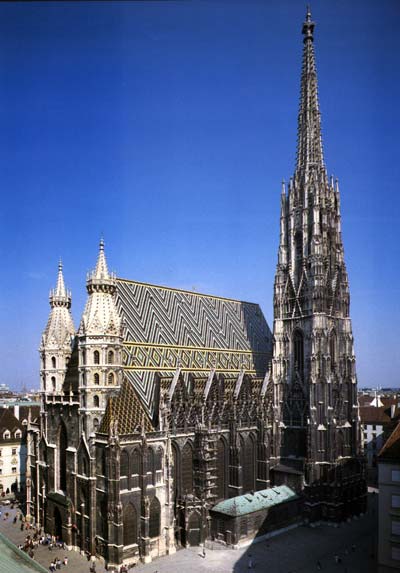 |
||||
|
St. Stephan's Cathedral, Vienna |
||||
The city's cathedral (called a "Dom" in German) is distinctive with its single spire. A matching second spire was planned but never built. Much of the Gothic edifice was damaged in World War Two. The Allies bombed the city to rubble. Before taking Vienna in 1945, the Russians shelled the city. Adding further damage, the retreating Germans fired back on the Russians. Much of what stands is a post-war restoration. All but the lower half of the shell of the church was destroyed. The stained glass appears to have been completely lost, but I couldn't find out exactly when. In Cologne, which was leveled in the war, the stained glass was taken out of the windows and stored in a bunker. It appears that that fate wasn't allowed the Viennese Cathedral glass. For the home of such a powerful empire, the Cathedral of St. Stephan is surprisingly small. It's pleasant, but doesn't convey to me the powerful sense of soaring religiosity of most other Gothic churches.
Vienna, as is fitting for a grand imperial city, is covered with magnificent buildings intended to act as structures of Hapsburg state propaganda, emphasizing their power and importance. It seems that on every street in the inner city there is a building crowned with the Hapsburgs' double-headed eagle.
The inner city of Vienna is compact. We were able to take a short walk from our hotel to the Hapsburgs' winter palace, the Hofburg. It's a virtual city within a city. Addition after addition over the centuries, each in the style of its time, turned it into a huge, rambling palace.
In the Hofburg, the most spectacular sight is the Schatzkammer or Imperial Treasury of the Hapsburgs. The only word that comes to mind now after having spent hours transfixed by one perfect work of art after another, is "dazzling". The Hapsburgs carefully accumulated or commissioned one magnificent piece after another and diligently kept them in the family through eight centuries.
The first thing that grabs one's attention upon walking into the treasury is a painting of Emperor Franz I, who was forced by Napoleon to abdicate the throne of the Holy Roman Empire. To make matters worse, he had to give his daughter Louise to Napoleon in marriage.
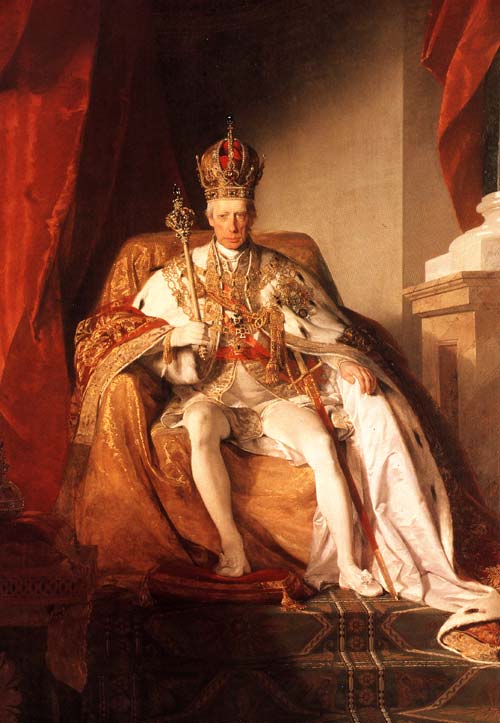 |
|||
|
Emperor Franz I of Austria |
|||
I'm sure Franz thought that this portrait of him sitting on the throne in grand imperial robes with staff and orb, symbols of his power, conveyed his majesty and strength. Perhaps my eyes have the perspective of a couple of centuries and what looked awe-inspiring two hundred years ago no longer does. It might be my American egalitarianism. To me, it looks as if the artist had intended to belittle Franz. It's a painting of an old man with skinny legs in tights. His large furs and robes make him look like a small, old man. I can't help thinking of the portraits of the Spanish Royal family by Goya. Goya in painting his royal subjects in unrelenting and perfect detail made them all look like idiots. Again, I don't know if this was a private joke on Goya's part or not. The effect, in the end, is to make both look foolish, obsolete and parasitical.
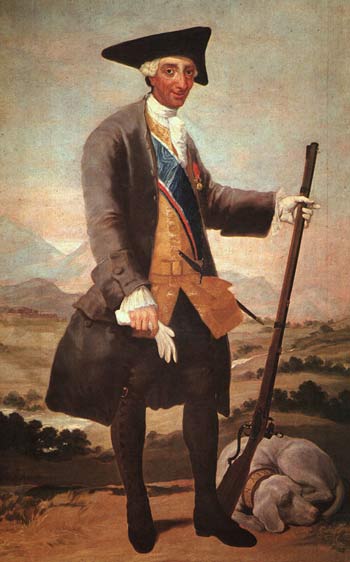 |
||||
|
Charles III by Goya |
||||
The collection starts with the ancient 10th century crown of the Holy Roman Empire, placed on the head of Otto I in 962. There is the lance that medieval man thought pieced the side of Jesus as well as what seems to me to be one of the thousands of the pieces of the true cross scattered across Europe. Swords, tapestries, jewelry, furniture: I have never seen so many perfect beautiful things in one place in my life.
This treasury was the movable wealth of the Hapsburgs. From the earliest days of the 14th century it was considered a common dynastic holding and not to be disposed of. As succeeding generations needed money, some of the objects were pawned for cash. But, the treasury remained basically intact. I know of nothing like this anywhere else in the Western World.
What else is here? The rocking cradle made for Napoleon's son; a solid gold christening jug and basin worked in unbelievable detail; a bowl cut out of
 |
||||
|
The crown of Emperor Rudolph II, and the crown of the empire of Austria from 1804. |
||||
a solid piece of agate 76 cm wide made for the court of the Roman emperor Constantine; beautiful embroidered robes made by Moslem workmen for the 12th century Norman kings of Sicily. The list goes on and on and on. This is one of those relatively unknown places that is almost worth, on its own, a transatlantic flight. I had no idea what I was in for when I bought my ticket.
After that, the idea of going to another museum seemed a bit much. We chose to spend the afternoon wandering the streets of Vienna, digesting what we had seen that morning. We did just that. No particular place stood out. It was the city in is entirety that we enjoyed. The buildings were beautiful. The city is immaculate. There is almost no trash. And on every corner there is a coffee shop where one can buy a delicious but extortionately expensive cup of coffee and a piece of thick, rich cake.
Tuesday, September 21
The Hapsburgs couldn't be content with just one magnificent palace in Vienna. They built a Summer castle on the outskirts of town, called Shoenbrunn. Like so many of the other kings, dukes, princes and other assorted nobility of Europe, the Hapsburgs wanted to build a castle to equal or excel Louis XIV's Versailles They couldn't do it. Many tried, but no one could. The Hapsburgs were too practical and sober to build something as foolish and magnificent as Versailles. Versailles put the Bourbon dynasty of France on the firm straight road to revolution. Versailles destabilized the finances of the country and forced the kings of France to call in successive parliaments to approve of ever greater taxes. The parliaments, sensing the aristocratic weakness and unceasing need for funds, started to assert their power. The trip to the guillotine for Louis XVI and his Hapsburg bride Marie Antoinette (daughter of Maria Theresa of Austria) was inevitable.
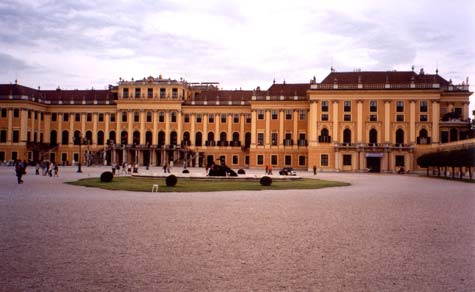 |
|||
|
Shoenbrunn Palace, Vienna |
|||
The Hapsburgs were prudent Teutons, not Frenchmen drunk on La Gloire. So the Hapsburgs, with some troubles, watching their bank accounts as closely as their borders, hung on to power for an extra 122 years after Louis lost his head right where the Tour de France races its final stage.
The Tour of the Shoenbrunn palace is well done. The private rooms really let the historian (OK, tourist) get a bit under the skin of the rulers of Austria. I don't think I would like to have my life put on such public display. The private toilets seemed to be of particular interest to most of my fellow tourists. And we make fun of dogs sniffing a fire hydrant.
The opening hours of most of the Viennese tourist sites are complicated. This, just like being a tourist in Italy, necessitates either careful checking and planning or backtracking and revisiting closed buildings. By default, I usually end up doing the latter.
Vienna is a Baroque City, and one of the best hits of splendid baroque visual overkill is the church of St. Peter. The second time around it was open. It has an orderly, plain exterior, but the inside...my goodness gracious me.
We thought we would try to squeeze in a visit to the famous Spanish Riding School, home of the Lipizanner trained horses. Closed, of course.
The Spanish Riding School is part of the Hofburg Palace. While we were there, we popped into the church of the Augustinians. This small church is the Hapsburg family church and has a beautiful, no... beautiful and moving tomb by the great sculptor Canova for one of the daughters of Maria Theresa. While we were there the organist practiced playing some beautiful contrapuntal music. I wasn't at all familiar with it, but I sure didn't want to leave.
We finished the day off with a visit to the Austrian National Library. This is not anything like any library you have ever been to. The Hapsburgs pulled out the checkbook for this one. Pictures don't do it justice, although here's an attempt.
 |
|||
|
The Austrian National Library |
|||
Wednesday, September 22
Museum of Fine Arts (Kunsthistorisches Museum). This museum almost makes the entire trip to Europe worthwhile. What a magnificent collection this is, and so beautifully displayed. I really had no idea of the riches that were squirrelled away here. The famous Breugel the Elder paintings of peasants eating or hunters returning, they're here. There are paintings by Raphael, Drurer, Veronese, Tintoretto, Van Dyke and Valasquez. All first rate. This was originally part of the Hapsburg family treasure, but was split away from the rest of the treasury in the early 19th Century. As early as Maria Theresa in the 18th Century the paintings had been put on view to the public. I can't tell you how pleasant the galleries are. If you are tired of the crowds of the Uffizi or the Louvre, come here to see wonderful art.
There were two disappointments. I had always wanted to see the famous Salt Cellar by Benvenuto Cellini. I admit it. I am fascinated by the old egomaniac. I love his autobiography (don't mistake it for accurate history) and make sure that I visit his big Perseus bronze whenever I am in Florence. But, the Salt Cellar was stolen. Here's a picture of it. If you see it at a garage sale, you might want to give the Austrian government a call. They're looking for it.
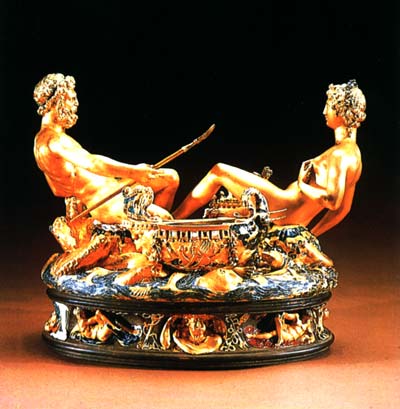 |
|||
|
The missing salt cellar by Benvenuto Cellini. |
|||
The famous Vermeer painting, Allegory of Painting, was on loan to a Japanese museum. If you have never seen an original Vermeer painting, you will understand how unhappy I was to see a blank spot on the wall with a note telling of the loan. A Vermeer cannot be reproduced. Vermeer's painstakingly applied layers of translucent glazes give a luminous, three-dimensional quality that no printing system has yet been able to copy. To see one of these masterpieces should be the goal of any sensitive human being. And the damn Austrians had loaned theirs to let someone else enjoy Vermeer's genius. That's very nice of them, but I had plans.
Again, after seeing so much that was beautiful and moving, we decided again to spend the afternoon walking in old Vienna. We came to the famous Secession House Here, a group of young artists led by Gustav Klimt set up a gallery in opposition to the Academy. Over time, our sensitivities change. The building was thought to be quite shocking at the time.
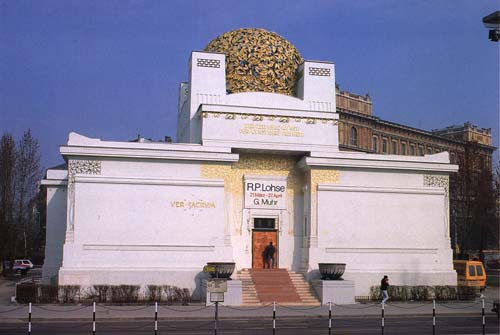 |
|||
|
Secession House, Vienna |
|||
By the way, the Secession House is just around the corner from the Art Academy where a young Adolf Hitler had sought admission. It would have been good if the admission people had seen merit in Hitler's submissions.
Thursday, September 23
The day was reserved for a train trip from Vienna to Prague in the Czech Republic. Am I the only person who still wants to call it Czechoslovakia? As we crossed the Czech Republic, the cities seemed to vary widely. Some looked to be decaying old mill towns. I imagine that they are the remainders of the old Soviet influenced system, obsolete. Then, the next city would be shining and fresh. Pulling into Prague after 5 hours on the train (with power plugs for computers, I might add), we had to get Czech Crowns because our Euros were no good here. The Czechs aren't yet part of the Euro Zone.
Again, figuring out the mass transit system wasn't hard. We were sped on a clean subway to our stop. When we came up to the surface, it was pouring rain and we had a mile of cobbles to cover with our luggage. Sweet.
Even in the rain, the streets were packed with people. This is a very busy city.
We arrived at our hotel, the U Karlova Mostu ("At the Charles Bridge"). We were informed that the hotel was overbooked and that there was no room for us. I knew the city was fully booked. I was about to blow my stack because we had just sent a re-confirmation fax a couple of weeks before, when they told us that there was a room waiting for us across the street. And a very nice room it was. It was part of a long-term residence hotel and it vastly exceeded my expectations. The staff was deeply apologetic and during our days there, treated us beautifully. We all make mistakes. It's how you take care of the mistake that matters. I'll expect perfection from others when I'm perfect.
Friday, September 24
The rain was just light enough to entice us outdoors and just heavy enough to make being outdoors a wet chore.
Before one notices anything else, the beauty of the buildings, the charm of the old squares, one notices the crowds. I always thought Florence near the Signoria to be one of the most tourist-packed places on Earth. I'm not sure, but I think Prague beats Florence. For 200 yards in any direction from the Charles Bridge which crosses the Prague-bisecting Moldau river, the streets are just filled from sidewalk to sidewalk with tourists from all over the world.
When the Iron Curtain fell Carol wanted to get to Prague as soon as possible. She wanted to see an intact Baroque city before Coca-Cola, McDonalds and the rest of the Fortune 500 companies changed it into more of the same homogenized corporate sameness that greets the traveler wherever he goes. I don't know what Prague looked like in 1989, but I suspect we waited too long.
My visitor's eyes had only two and a half days in Prague, so I hardly can be counted as an authority. It seems that Prague has made a Faustian bargain. In return for what are clearly massive tourist dollars, almost all store-fronts in the old city are entirely devoted to selling goods and services to tourists. Most of the great cities are living things. Even Assisi with its kilometers of street devoted to selling kitsch to tourists still has a lot of its commerce devoted to the need of its residents. One doesn't get that feeling in Prague.
But, I said it's a Faustian bargain. We get something in return. All the buildings are beautifully restored. What isn't perfect is well on its way to being so. So, we live with the crush of humanity and marvel at the beauty.
I think that Prague is unique among major Central European cities in that it has not sustained any war damage since the War of Austrian Succession and the Seven Year's War. It escaped damage from the Napoleonic Wars and the two World Wars. This makes is a jewel among the cities of Europe in which one can really see what we lost in our lust for mutual slaughter.
In the late 1950s and early 1960s, there was a tv show on Sunday evenings called "The Twentieth Century", hosted by Walter Cronkite. Its focus changed in later years, but in my childhood, I remember that it was usually about World War Two. One of the starkest memories I have as a small boy was watching newsreel movies of the German bombardment of Warsaw. Lit by the flames, I still remember the elaborate building facades crashing to the street. Even then I thought that beyond the horror of war, something from the past was being lost forever. When I first went back to Germany, those cities of bygone years were gone and replaced with 20th Century glass boxes. Here and there, for example in Cologne, were a few careful reconstructions of old buildings, but for the most part it was lost. To attempt such a wholesale rebuilding would be beyond the ability (and perhaps the interest) of any people. I yearned to see what had existed before the war, but felt that could never be.
In Prague I found my fondest wish to have come true. Mile after mile of beautiful old buildings, built up over the centuries greeted us. The city is a beautiful jewel.
And looming up on the hill is the castle. It is so big that it holds within its wall an entire Gothic Cathedral big enough to require flying buttresses to hold up its soaring nave. Started in the 9th century, the looming hulk dominates the city. No matter where you are, the giant castle is visible. We spent the day just wandering in the little streets of what is called the Lesser Town (12th Century) on the western side of the Moldau River, saving the Old Town (also 12th Century) for the following day.
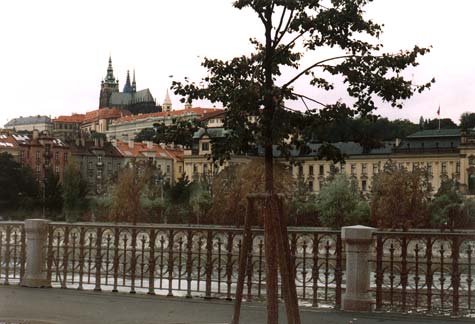 |
||
|
A veiw of the Prague Castle, with St. Vitus Cathedral, from the east side of the Moldau (Vltava) River. |
||
Saturday, September 25
Today we chose to visit the Old Town part of Prague with it's famous Wenceslas Square, the old Jewish Ghetto and mile after mile of wonderful streets in the New Town (14th Century!), each a sight to behold. I can only hope that a few of my pictures does the city justice in your mind. We walked through the Old Town Square. This area of Europe, known for centuries as Bohemia was a hotbed of protestant dissent during the Reformation. One of the originators of the protestant reformation, Jan Hus almost set Europe on the road to reformation a century early.
Hus followed the teachings of the English dissenter Wyclif. We still have Hus' annotated copies of Wyclif's teachings. Preaching from his pulpit in Prague, Hus said almost everything Luther would say a century later. When confronted by an angry church, he used the same argument Luther would. "Show me in scripture where I am wrong and I will recant". Given a safe-conduct to the Council of Constance, he was thrown in jail and later burned. Hus' arguments against transubstantiation, indulgences and the infallibility of the Pope were not new, but they electrified Bohemia and set the region ablaze.
Luther was able to use German Nationalism and the resentment of the German princes to gain protection from the Church. It was just too early for Hus to have survived his courageous preaching. When the ever-so-Catholic Hapsburgs took over Bohemia, they worked to exterminate any memory of Hus. Today his statue stands in the Old Town Square, a monument to how great a man can be.
We wandered up to Wenceslas square where the Czechs celebrated the fall of the Iron Curtain.
In Prague the Jews were required to live in the Ghetto until 1848. Today, looking at the past, we can only be mystified at how our ancestors ordered their societies. I wonder what stupidity we have recently committed will equally horrify our descendents. Sending the Japanese to Manzanar? Locking our fellow men up in cages under appalling conditions in Guantanamo? It's easy to see the terrible wrongs of the past as we enthusiastically commit new ones.
The little in the ghetto graveyard holds more than 20,000 graves. Because the city forbade Jewish burial elsewhere, the dead were buried vertically. The inventiveness of human beings in committing indignities against each other can be appalling
From here we walked out of the ancient part of the city and into what I assumed to be the 19th Century addition to the city. Forever the streets seemed to be lined with terrific facades. I don't think any city I have ever seen has such a unique, rich character to its streets. We walked until we couldn't walk any more.
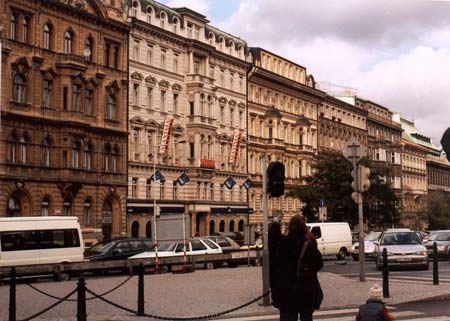 |
||||
|
A fine Prague street. |
||||
And then the trip was over.
Flying out of the Prague airport it was nice to see that the Czechs were unafraid to charge about $4.00 for a cup of coffee at their airport. They have truly joined the modern world.
Thank you, patient reader.



